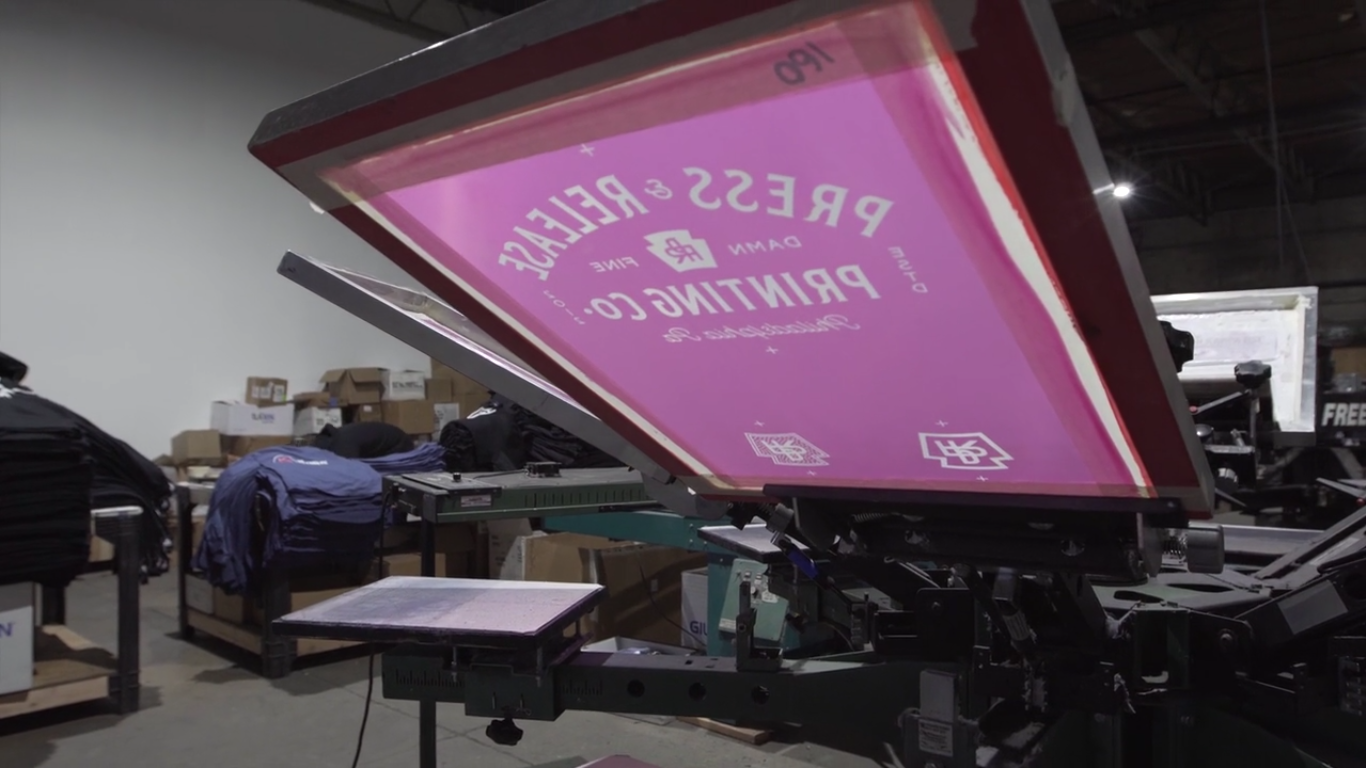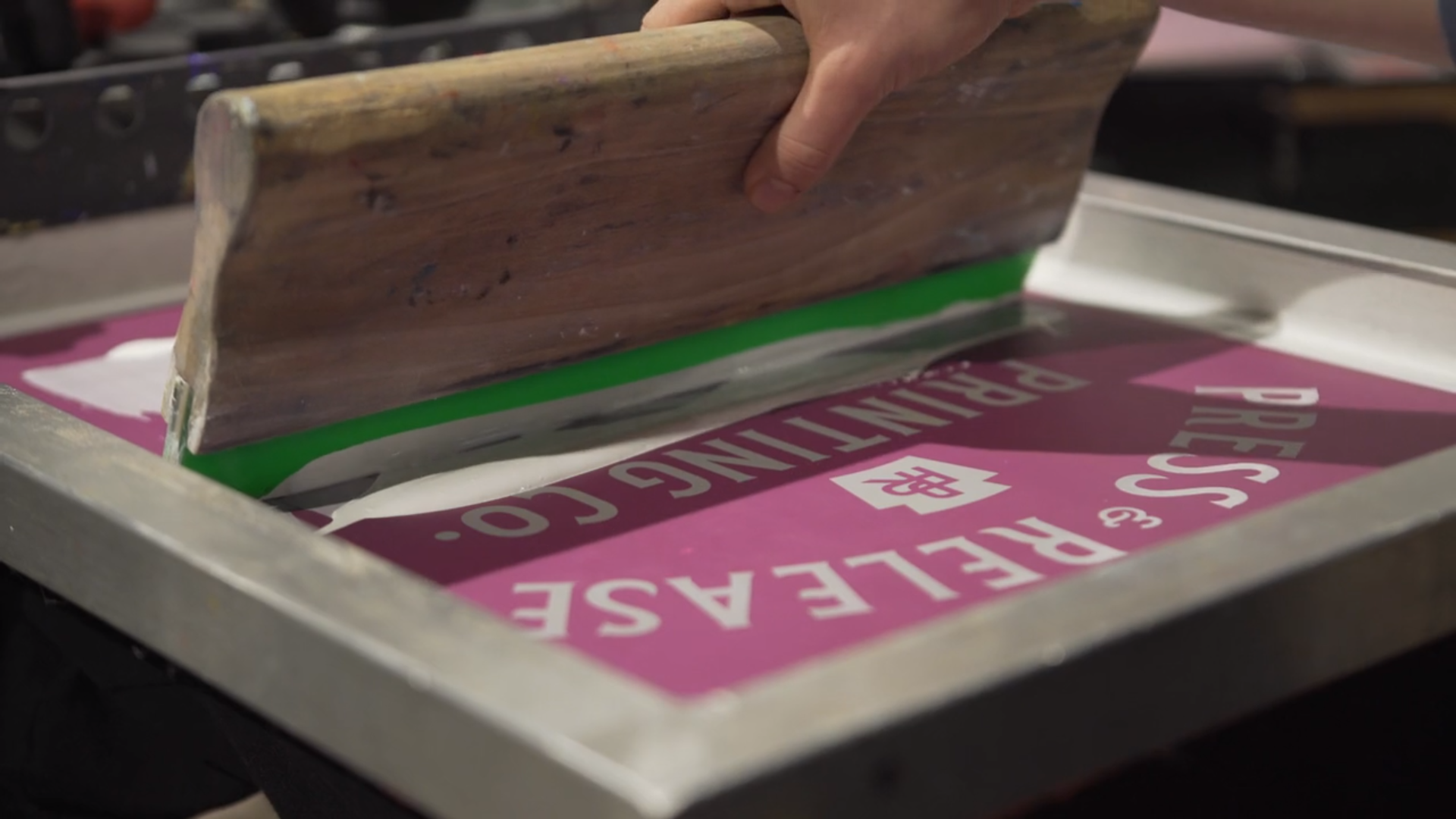Bring Your Vision To Life With The Most Trusted Philadelphia Screen Printing Company
Screen printing is the art of pulling ink through a fine mesh in order to imprint a design onto a substrate (it’s a fancy word for t-shirt or whatever you’re printing on). Modern screen printing hasn’t ventured far from its ancient origins as a manual printing method, even at an industrial scale. Screen printing has remained the most cost-effective way to decorate apparel, especially in bulk. Odds are, most of the graphic tees you’ve come across have been screen printed.
Screen printing was developed in early 3rd century China as a way to print drawn designs onto fabric. The process was picked up by Japanese artists, who modified the technique using paper stencils, mesh screens made of hand-woven hair, and rigid brushes. This was common practice until the 17th century, when French printers began using silk screens to support stencils. By the Industrial Revolution, screen printers had dropped the brush and picked up the squeegee in order to produce at a larger scale — and we still use them today.
Contemporary screen printing, of course, looks a bit different:
- Prepare artwork for production: To screen print your design, it must first be vectored. Each color is then separated into its own layer.
- Print film positives: Individual layers are sent to the film printer and transferred to a film positive.
- Burn screens: Once films are printed, they are burned onto a screen coated with light sensitive emulsion. After each screen is washed out, the negative image remains open in the mesh.
- Place inks in screens: Custom inks are mixed, and standard inks are scooped from their buckets. These inks are carefully placed in the corresponding screens (our films have the ink color listed, so printers can easily see which ink color goes in each screen)
- Print: Once screens are properly registered, and loaded with the correct ink, a squeegee is used to press the ink through the screen’s fine mesh.
- Cure: Once ink has been applied, the fabric is fed through a conveyor dryer, where heat cures the newly-pressed ink properly to the garment.
- Quality control: After garments leave the dryer, they are carefully inspected before they are folded in bundles by size, and repacked for shipping.
This process allows for the creation of bold, vibrant graphics on the product of your choosing.
Screen printing is the most flexible and accommodating option for most orders because it allows designs to be replicated rapidly without sacrificing quality or incurring a high cost. If you’re looking to outfit your office staff in a pinch, load up on branded merch before your restaurant’s grand opening, or keep a popular print stocked in your store, this service is likely your best bet.
| BENEFITS | LIMITATIONS |
|---|---|
| Cost effective – especially for large orders | Minimum of 24 pieces required |
| High quality prints that last for years | Maximum of 8 colors per location |
| Can be used on a variety of garment colors and styles | Requires the use of halfones to create full color designs |
| Allows for exact PMS matches | Not ideal for hats or other bulky/non-flat items |
Ink Types
Unlike many other shops, we pride ourselves in the ability to offer a variety of ink types as unique as your project. We are able to match the specific PMS values you require, at no additional charge.
Plastisol is the most widely used ink for screen printing today. This PVC based ink sits on top of the garment’s fibers, allowing for great coverage on light and dark garments. It’s unmatched when it comes to bright colors on cotton and blended garments, and is the most accurate when it comes to matching Pantones. These inks are very durable, and when properly cured, prints will last for years.
Waterbased ink is exactly what it sounds like, ink that uses water as a solvent. This ink is very thin (like water), so it soaks directly into a garment’s fibers, resulting in a very soft print. It’s primarily used on light, 100% cotton garments. Using it on blended shirts can create a cool “vintage” look. These inks typically wear with the shirt, resulting in a well loved look over time.
Discharge is a waterbased ink containing a bleach-based agent. Once it is absorbed by fabric, this ink is effectively a dye. Discharge ink allows for extremely soft prints (once washed). It can produce incredibly vibrant colors (on 100% cotton garments), but it’s very reactive to a garments color and blend. Discharging garments with a low cotton content is not recommended. Although custom colors are available, Pantone matches are not as accurate as plastisol.
Athletic inks are similar to Plastisol, however they have a lower cure temperature, and contain blocking agents that prevent dye migration on dyed fabrics such as polyester. These inks allow for screen printing on more delicate garments that are highly reactive to heat.
Specialty inks are also available at Press & Release. We offer glitter inks, shimmer inks, puff inks, foil, etc. If you’re looking for something to help your print stand out, we’ve got you covered!
Turnaround
Our standard turnaround for screen printing orders is 15 business days (approx. 3 weeks, excluding holidays).
Expedited orders may be available for an additional fee, depending on our availability and the scope of your order. Please contact us directly if you need to meet a specific deadline.
Pricing
When it comes to pricing your screen printing job, we stick to the basics:
-
- Quantity: How many pieces would you like to order? We have price breaks at quantities of 24, 36, 48, 72, 100, 144, 300, 500, and 1,000. Have an order for 2,000 pieces or more? Contact us directly and we will determine special pricing.
- Color: How many colors are in your design? Please note: If you will be printing a color onto a dark shirt, an underbase (a base layer of white ink that helps the color pop) will be required and will count as an additional color.
- Location: Where will your design(s) be printed? Specialty locations (sleeves, hoods, pant legs, etc.) will incur an additional fee.
Curious about how much your project will cost? Check out our instant quote calculator!
Artwork Specifications
We aren’t especially picky, but when it comes to your design, we do prefer vector files — and so should you. Vectors (.ai, .eps, .svg) allow your image to scale infinitely without taking a hit on quality. If your design isn’t in the vector format, no need to worry, our design team will happily assist you!


